These days, employee telecommuting is becoming more common than ever before. And, with more and more individuals finding themselves capable of working from home, the need for viable home offices is one that is being felt all around the world. After all, in order to maximize productivity, a designated, organized space in which to work is absolutely essential. In short, if you aren’t going to travel to the office, you need to be able to bring the office home to you.
Unfortunately, due to size and room constraints, many apartment renters who work from home neglect to set aside space for a home office. As a result, they find themselves distracted, disorganized, and disappointingly unproductive. However, the fact of the matter is that having a home office doesn’t always necessitate having a spare, unused space. With a little bit of ingenuity, it is possible to create a completely practical home office from whatever space is available in the apartment, and to make it look good in the process.
We’ve compiled a list of tips and decorating ideas for home offices that will help you stay productive and professional, even if you’re working out of your living room (or bedroom, or den, or wherever). As always, make sure that you get permission from your property manager before you make any permanent changes to the apartment, and always consider hiring professional help if you don’t feel up to completing a project on your own. Read on to discover more!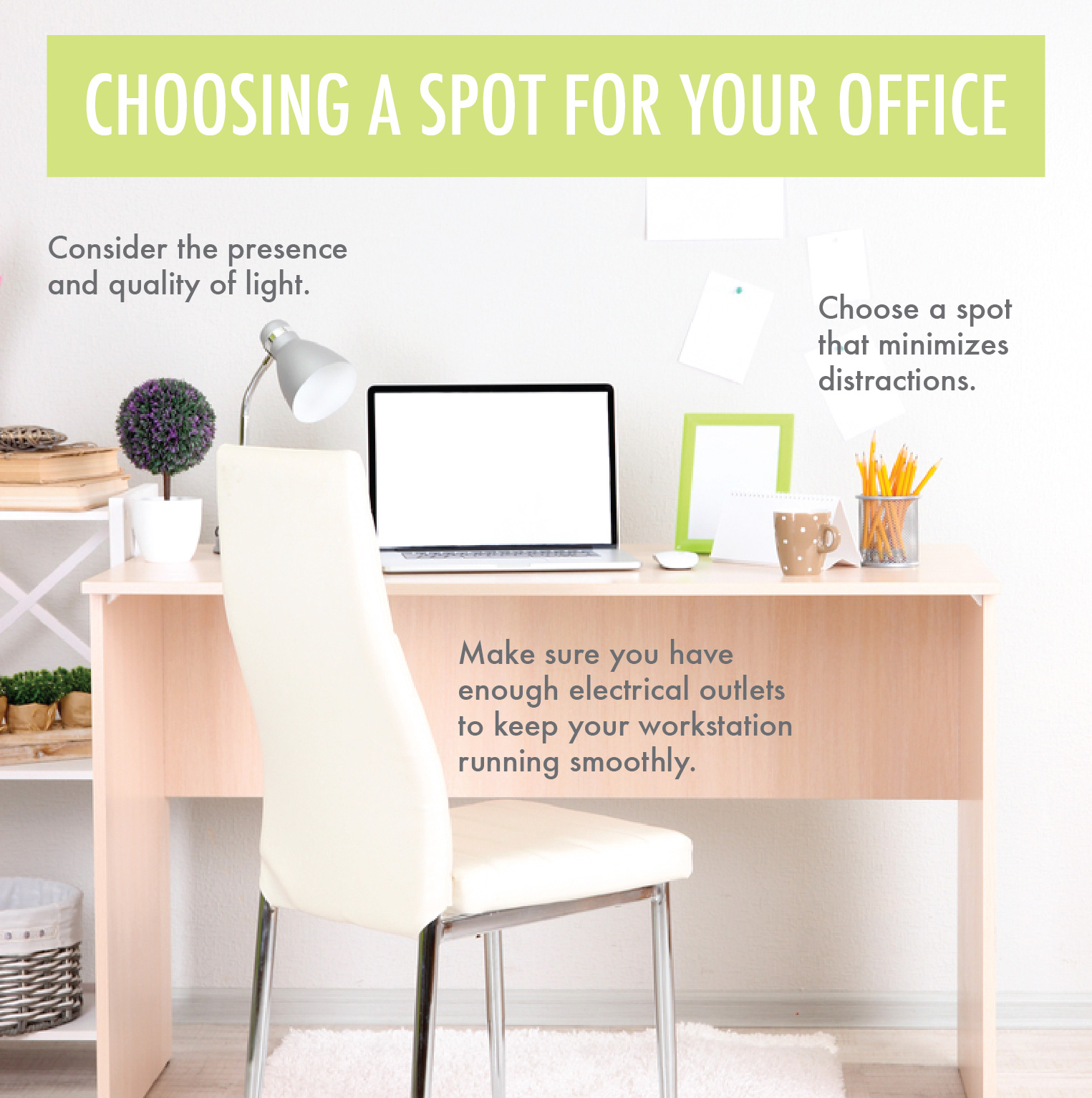
Choosing a Spot for Your Office
Before you can start trying out your home office decorating ideas, you first need to take complete inventory of every room and available space in your apartment. How many rooms do you have? How are those rooms currently being used? Are there any spaces in your apartment that are being underused? By developing an accurate, comprehensive picture of how you are presently using your apartment’s available space, you’ll be able to better locate the right spot to designate as your home office. Here are some tips to help get you started:
-Choose a spot that minimizes distractions. Perhaps the most difficult part about working from home is the constant potential for distraction—ringing phones, knocks on the door, pestering pets, and even family members can all end up chiseling away at your much-needed focus. So, one of the first steps to creating your own home office is to try to find a location that minimizes the impact of these distractions. If you share your apartment with others, try to find a spot that is located away from high-traffic areas. Additionally, keep in mind that having a television in the same room as your office may have a negative effect on the quality of the work you do. And, if you find yourself tempted to take constant snack breaks, remember that having a bit of distance (and maybe even a door or two) between your office and the kitchen may be a wise choice.
-Consider lighting. People tend to make a big deal about the importance of quality office lighting. This is because poor lighting can contribute to workplace injuries, low-quality performance, and even negative health issues. When designating a spot for a home office, the presence and quality of light should be a major consideration. A home office with a nearby window will allow natural, diffused light to illuminate your work—as long as it doesn’t blind you or produce too much glare on your computer screen when the sun is low on the horizon (windows that face north/south are preferable to those that face east/west). Additionally, home office light fixtures should produce light that is indirect so that it doesn’t end up creating dark shadows across your work area. Layered, diffused light will give you the best illumination for the times when natural light isn’t a possibility. Take a look at this handy government resource to help determine the effectiveness of your office lighting.
-Don’t forget about outlets. Although a large number of office workers have recently begun to rely heavily on wireless mobile devices, the fact remains that for the greater portion of office work, a stationary work station is a necessity. This means that your home office is going to need to be located somewhere with enough electrical outlets to keep your computer, second monitor, printer, light fixtures, and any other electrical equipment running smoothly. This doesn’t necessarily mean that you need to find a spot with several available outlets; a surge protector power strip can often provide you with all of the outlet spots that you need while also protecting you from voltage spikes. Still, you’ll likely need at least one nearby wall outlet to get you started.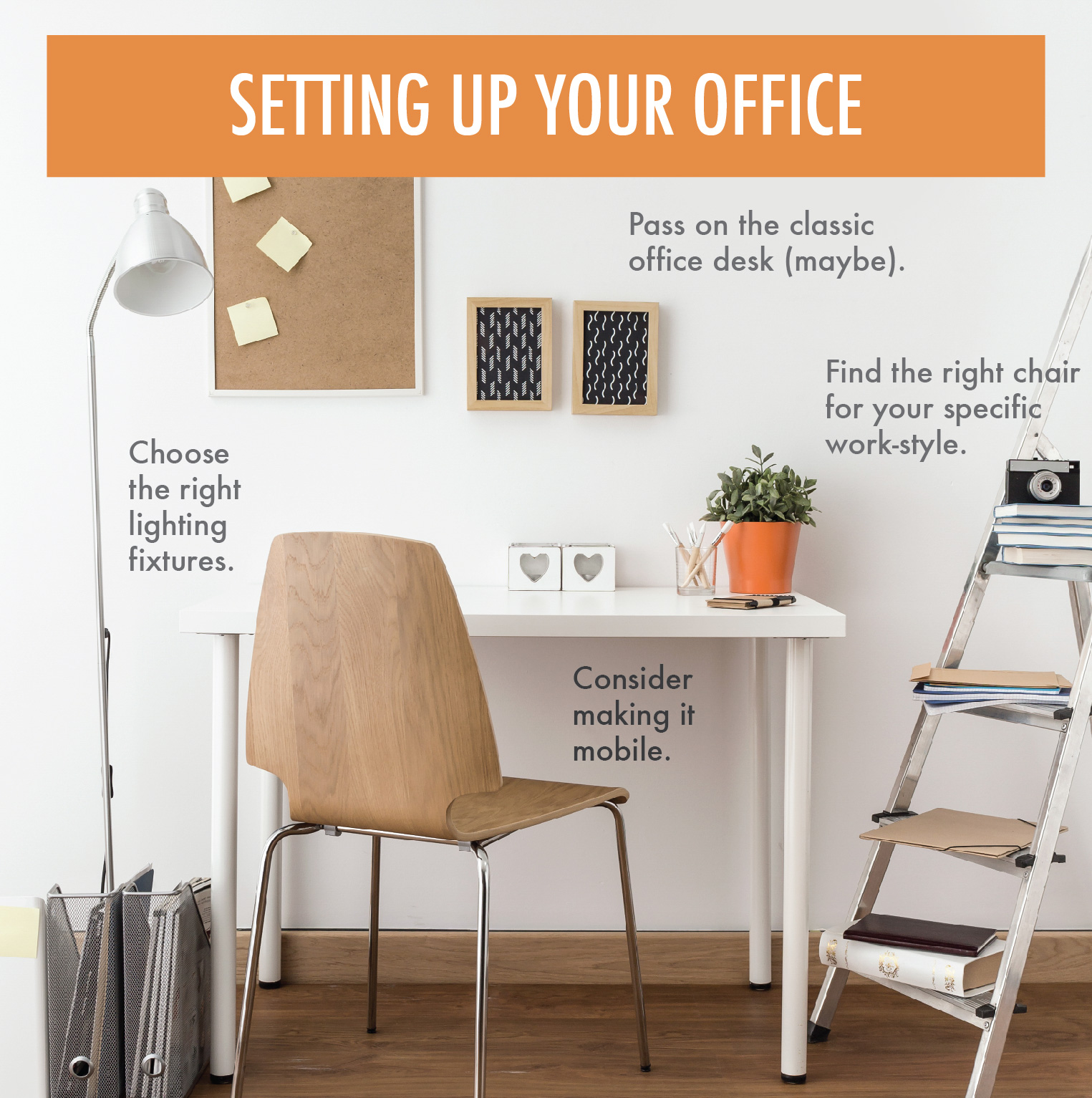 Setting Up Your Office
Setting Up Your Office
Once you have a space that you want to dedicate to your office, the next step is to design the office space itself. Your level of productivity while working at home will depend largely on the overall arrangement of your office. And while every individual has their own office preferences when it comes to motivation, there are a few basic tips that can help everyone get the most out of their workspace. Here are some that we found to be the most helpful:
-Pass on the classic office desk (maybe). If you have the space available to use a full-fledged office desk, then feel free to go for it. If, on the other hand, you find yourself, for whatever reason, shying away from the traditional desk design, then don’t worry—there’s no law that says you have to have an actual office desk in order to have an effective home office. For many offices that are located in rooms that serve more than one purpose, non-traditional desks make much more sense. For example, a closeable armoire with a pullout keyboard drawer can give you a dedicated workspace that can be hidden neatly away when not in use, while also providing additional organizational space for various papers and work-related items. Alternatively, a simple waist-high corner shelf, with one or two slightly higher shelfs set above it, can provide a utilitarian workspace that won’t infringe on your overall available apartment space.
-Choose the right lighting fixtures. As mentioned above, light is an important consideration to make when choosing a space for your home office. But beyond simply ensuring that your workspace is getting enough of the right kind of light, you should also pay close attention to the kinds of fixtures you are using. Your fixtures should be more than utilitarian; they should play a key role in the overall design and decor of your office. When contemplating decorating ideas for home office space, be sure to choose light fixtures that go well with your overall theme. At the same time, avoid harsh fluorescents or fixtures that create too much excess heat. Modern LED bulbs may be the perfect choice, as they produce a soft, bright light, while consuming less energy, producing less heat, and lasting significantly longer than conventional incandescent bulbs.
-Don’t forget about the chair. Unless you plan on designing a standing workspace (which does have its advantages), you’ll need to find a chair to use in your home office. But while many telecommuters simply chose whatever chair they already have sitting around the apartment, effective home offices are ones that have the right furniture. Your chair should conform to your specific work-style. Are you a mobile individual who is constantly having to move from one spot to another? Then a wheeled office chair would probably be best for you. Do you have trouble staying alert while you work? Then something that is comfortable—without being too comfortable—might be a better choice than something that makes you want to curl up and nap. Remember: Your chair should promote focus; Something firm that enforces good posture will serve you much better than a La-Z-Boy recliner.
-Consider making it mobile. If you’re having trouble coming up with the perfect spot for your home office, you might have a better time creating something that can be moved from room to room (or even to another building entirely). A mobile office can give you the freedom to change locations without limiting productivity. Of course, to take advantage of this, you’ll need to know how to make a mobile office. A closable, wheeled desk that provides enough surface area while still being small enough to be easily transportable will allow you to escape to other rooms in the event that your intended office space is being used for something else. And if you find yourself having to do a lot of work while away from home, a large backpack or briefcase in which fits a compact laptop computer, a portable light fixture, and perhaps even a small mobile printer, will make it possible for you to take your office with you wherever you go.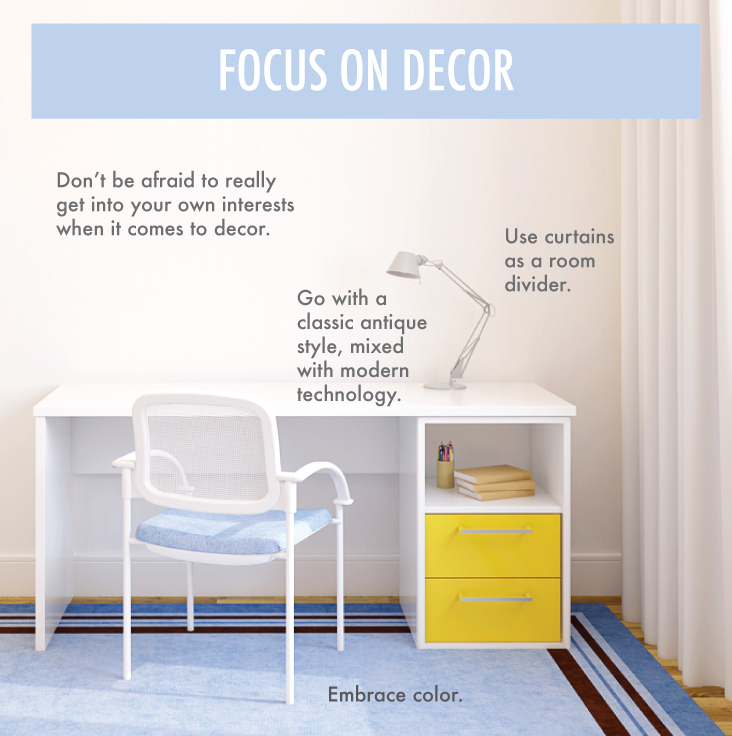
Focusing On Decor
A home office, first and foremost, should be a place that is conducive to getting work done. That having been said, if your office is located in a room that is being used for other purposes, then you’ll probably want to make sure that the overall look and design of your workspace is congruent with the rest of the decor. Here are some decoration ideas for home office space that should help you get a feel for how you want your office to look:
-Embrace color. Most modern offices have the same basic color scheme: light, unobtrusive colors (such as white or taupe), off set by utilitarian blacks, greys, or even metallic silvers. This is because offices are generally designed to appeal to (or at least not offend) a large number of people. However, you’re office only needs to appeal to you. This means that you have a bit more freedom when it comes to choosing hues. You can choose any colors or contrasts that you’d like for you workspace, but it is generally recognized that certain colors provide different benefits in a home office. Blue is a calming color, and promotes focus, and is a good choice for a base color, as it goes well with other colors that can be used as accents. Red, on the other hand, is a color that draws the eye and invokes feelings of passion and intensity. A red office might disrupt your focus, but when used as an accent color, it can actually help you remain motivated. A yellow office can help promote optimism and creativity, but may feel garish if used as a base color, and may also fatigue the eyes after a prolonged period of time. Green is much easier on the eyes, while also having a calming effect (similar to blue). Try a variety of color schemes, and see what sits the best with your own personal preferences (and the decor of the rest of your apartment).
-Use a room divider. There are going to be times when your home office simply does not fit in with the design scheme of the rest of your room. But rather than have the entire workspace stick out like a sore thumb, you can effectively hide it with a room divider. A room divider can be as simple as a decorative curtain or standing screen. When your office is not in use, the divider can be moved to block views of the office from the rest of the room. If you want something more permanent, consider building or purchasing a tall double-sided bookcase to create a small, out of the way office ‘nook’ that will keep the look of your office space from negatively impacting the look of your room.
-Write on the walls. Do you find yourself using a lot of adhesive notes in your office? There’s nothing wrong with you if you do, but you might find that dozens of little, yellow pieces of paper stuck to every surface have a way of throwing off your intended decor scheme. You can eliminate the need for adhesive notes simply by painting the walls of your office with either chalkboard paint or whiteboard paint. Chalkboard paint will give your walls a unique, flat look that can be very interesting and enjoyable, especially when contrasted with white or light-colored furniture. Whiteboard paint is less noticeable, and may be a better choice if you are looking for something more standard. Just keep some chalk or dry-erase markers on hand so that you’ll be able to take notes whenever you need to.
-Go antique. Office decorating ideas don’t have to be off the wall or crazy; sometimes a classic look coupled with modern technology provides a ‘best of both worlds’ scenario that will give your office an atmosphere of dignity. Use antique furniture, along with other stylishly aged fixtures to project a feeling of nobility onto the work you do. If you can find (or can’t afford) actual antique furniture, it is possible to ‘antique’ new furniture through various DIY processes. Just make sure to do your research so that you don’t end up ruining your furniture.
-Focus on your interests. When you work in a corporate office, you may have the freedom to decorate your own workspace to some extent. That having been said, most office buildings have a limit to the amount of personalization they allow. Your home office has no such restrictions. So, if you want your entire office to be Superman themed, or make extensive use of your collection of sports memorabilia, or feature nothing but animal print upholstery on the furniture, then that’s your choice. Have fun when designing your office, and don’t be afraid to really get into your own interests. Just be aware that too much personality can have a negative effect on your productivity. On the other hand, a comfortable, personal workspace can help to inspire and motivate, so find the balance that’s best for you.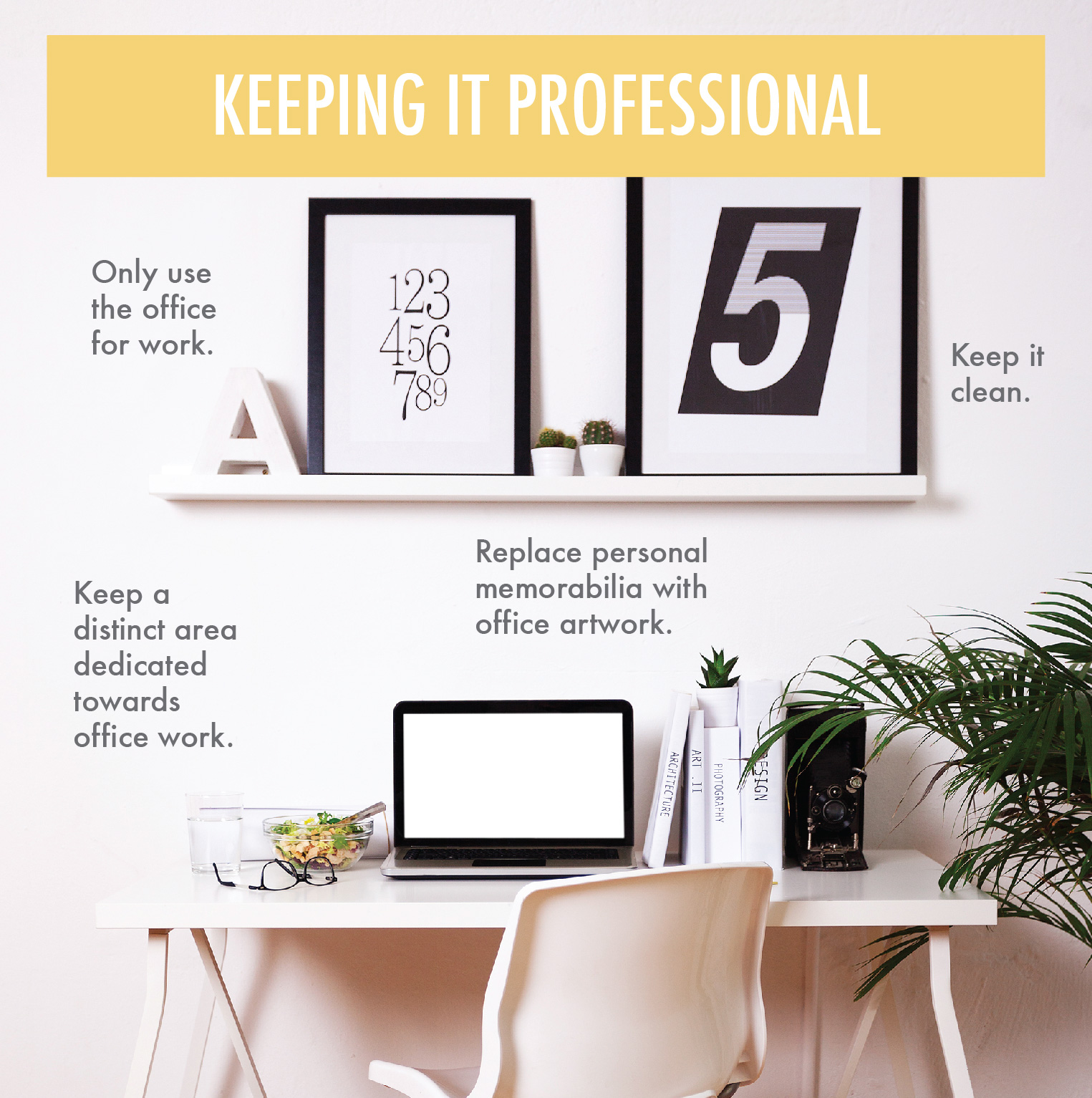
Keeping It Professional
If you plan on regularly working out of your home, then you need to recognize that your financial prosperity is directly tied to the effectiveness of your home office. As such, it might be in your best interest to ensure that the area you designate as your workspace retains an air of competence, respectability, and professionalism. Even if you don’t plan on ever meeting directly with clients or coworkers in your home office, the overall ambience of your workspace may still have an impact on your productivity. Unfortunately, knowing how to maintain professional status while at home is not a skill that many telecommuters inherently have. Here are some tips on how to keep your home office looking and feeling professional:
-Separate it from the rest of your apartment. We mentioned above that adding some form of room divider can be a way of preventing the look of your home office from clashing with the decor of the rest of your room. It can also help keep your office feeling professional. Having a separate, distinct area dedicated completely towards office work will help you maintain a professional mindset. To this end, try to set aside an entire spare room, or at least an entire section of a room, to your office, and do what you can to keep the boundaries between office and non-office clear.
-Only use the office for work. Another way to help ensure a professional atmosphere in your home office is to make sure that your workspace is only used for office work. This may be difficult, especially if your office is located in a common room. Still, your productivity might depend on your willingness to declare the office area ‘off-limits’ in regards to any non-work related activities and personnel. This means keeping children, pets, roommates, and even yourself (when not in work-mode) out of the office. Sure, it might be difficult to accomplish, but by designating your office space as ‘work-only,’ you’ll be helping to keep everything as professional as possible.
-Don’t get too personal. We told you that you have the right to decorate your office in any way that feels right, and we stand by that declaration. That having been said, too much in the way of personal flare has a way of making an office seem informal, and by extension, unprofessional. Keep your office looking authoritative by replacing personal memorabilia with office artwork, inspirational quotes, and other classic office decorations. The goal here is to trick yourself into feeling as though you are working in an office building, so be sure that you also remember to dress the part—t-shirts and sweatpants may be comfortable, but they won’t help you get into a properly professional mindset.
-Keep it clean. It’s been said that cleanliness is close to godliness, and while we can’t really confirm or deny the accuracy of that particular statement, we can promise you that a clean work area feels much more professional and productive than a cluttered one. Make sure that you have enough storage and organizational space to contain any items supplies, papers, or other odds and ends that you might need in order to do your work. This will help keep clutter from spilling onto your work surface. Additionally, schedule a regular cleaning session every week (or possibly even every day, if you feel that you need it) during which you can take 10–15 minutes to throw away trash, organize papers, dust off monitors, and do every other office-cleaning chore that might otherwise be ignored. Your home office can be as effective as any corporate building, but it probably won’t have the advantage of being able to rely on a regular janitorial service. Instead, the cleanliness (and professionalism) of your office is your responsibility.
Did we miss anything? Share your own home office tips in our comments section!
A Guide to Designing and Getting the Most out of Your Home Office
Apartment Living
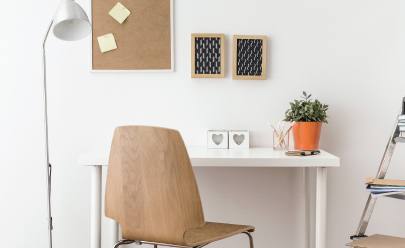
Recommended Articles
Apartment Living
10 Min. Read
6 Best Smart Devices for Your Rental
Just because you live in an apartment doesn’t mean you can’t have a “smart home.” Even with limited square footage or strict lease parameters, there are plenty of smart devices that can elevate your…
Apartment Living
9 Min. Read
Best Tips for Renting with Roommates
Renting with roommates has its ups and downs. Yes, it saves you money on rent and living expenses. And yes, sometimes it means having a built-in best friend right at home. However, sharing a…
Apartment Living
7 Min. Read
15 Tips for Renting an Apartment with a Pet
Renting with a roommate can be difficult -- especially when they’re furry, four-legged, and attached to your hip. Yes, we’re talking about pets, both a man’s best friend and a renter’s biggest challenge. Whether…
Apartment Living
6 Min. Read
How to Create a Magical Color Palette for a Jolly Holiday Season
There’s no wrong way to decorate for the holidays. Perhaps you’re a traditionalist, favoring greens and reds. Or maybe you like to be a little different, opting for a black tree adorned in purple…
